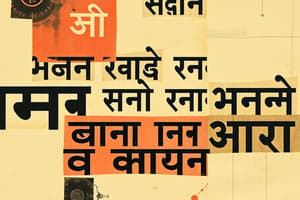Podcast
Questions and Answers
Which type of consonants are pronounced with the vocal chords vibrating?
Which type of consonants are pronounced with the vocal chords vibrating?
- Voiced consonants (correct)
- Unvoiced consonants
- Ascending consonants
- Descending consonants
What type of consonants are pronounced without the vocal chords vibrating?
What type of consonants are pronounced without the vocal chords vibrating?
- Voiced consonants
- Descending consonants
- Unvoiced consonants (correct)
- Ascending consonants
How are vowels represented in Devanagari script?
How are vowels represented in Devanagari script?
- Using dots only
- Using diacritics called _vyanjana_ (correct)
- Using lines only
- Using symbols
Which vowel in Hindi can be either short or long depending on context?
Which vowel in Hindi can be either short or long depending on context?
How are numbers written in Hindi from 1 to 9?
How are numbers written in Hindi from 1 to 9?
What makes the Devanagari script an attractive choice for writing Hindi?
What makes the Devanagari script an attractive choice for writing Hindi?
What is the Devanagari script known for?
What is the Devanagari script known for?
How are vowels added in the Devanagari script?
How are vowels added in the Devanagari script?
What is an abugida writing system?
What is an abugida writing system?
How many vowels are there in Hindi according to the text?
How many vowels are there in Hindi according to the text?
In which direction is the Devanagari script typically written?
In which direction is the Devanagari script typically written?
What is the Devanagari script mainly used for?
What is the Devanagari script mainly used for?
Flashcards are hidden until you start studying
Study Notes
Hindi: A Language and Its Writing System
Hindi is a vibrant and essential language spoken by over 530 million people worldwide, primarily in India and surrounding regions. With a rich cultural heritage, Hindi has a distinct writing system that captures its unique identity. In this article, we'll explore the history and structure of the Hindi script, providing a foundation for understanding the language itself.
The Devanagari Script
The Devanagari script is the most prevalent script used for writing Hindi. This script originated in the 5th century CE and has evolved over time to become one of the most recognizable and elegant writing systems worldwide. Each character represents a consonant-vowel combination, and the script is known for its clarity and simplicity, making it easy to read and write.
The Devanagari script is an abugida, meaning each character is a combination of a consonant and an inherent vowel. The consonant is written first, and the vowels are added using diacritics called vyanjana. The script is written from left to right and top to bottom, with each line being written from left to right, and multiple lines stacked on top of each other.
The Consonant System
Consonants are written in the Devanagari script using a combination of symbols that represent their sounds. In Hindi, there are 11 vowels and 33 consonants. Consonants can be classified into various categories, such as:
- Voiced consonants: These are pronounced with the vocal chords vibrating, like "b," "d," and "g."
- Unvoiced consonants: These are pronounced without the vocal chords vibrating, like "f," "t," and "k."
- Ascending consonants: These are pronounced with a slight rise in pitch, like "ch" and "j."
- Descending consonants: These are pronounced with a slight dip in pitch, like "ny" and "tr."
Consonants are further classified into categories based on their pronunciation, such as nasal consonants, aspirated consonants, and retroflex consonants.
The Vowel System
Vowels are represented in Devanagari script using diacritics called vyanjana. There are 11 vowels in Hindi, which are written using a combination of dots and lines added to the consonant. The vowels are:
- A (आ)
- I (इ)
- U (उ)
- E (ए)
- O (ओ)
- AI (ऐ)
- AU (औ)
- AA (अआ)
- II (इइ)
- UU (उउ)
- EE (एए)
Each vowel can be short or long, depending on the context in which it appears. Long vowels are indicated by adding a dot after the vyanjana.
The Numeral System
Hindi uses a numerical system that is a variation of the Arabic numeral system. The numbers are written in a specific order and structure. For example, the number 1 is written as "1," the number 10 is written as "1०," and the number 100 is written as "1००." In Hindi, the numbers 1 to 9 are written with a dot, and the numbers 10 to 99 are written with a zero in between the tens and ones digits.
Conclusion
The Devanagari script has been a cornerstone of Hindi's rich literary heritage. Its beauty and clarity have allowed Hindi to flourish as a language, and the script's simplicity has made it an attractive choice for writing. The Hindi script's elegance and ease of use are key factors in its longevity and popularity, and whether you're reading a classic text or a modern novel, the Devanagari script will always be a delight to the eyes.
Studying That Suits You
Use AI to generate personalized quizzes and flashcards to suit your learning preferences.




